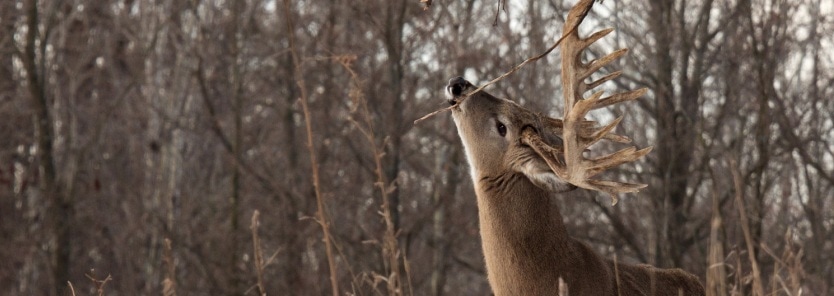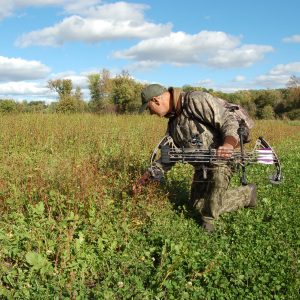The flurry of peak-rut may be over but any sign of a receptive doe and bucks can display vulnerable rut behavior again. On the other hand, after most of the does have been bred, a buck’s need to survive the upcoming winter makes them slaves to their stomach. The two angles below can be your best bets for connecting with a late season buck – which one will work best can be clarified with a little scouting.
It’s a fact that not all does are successfully bred during the main rut. This can lead to what some call a “secondary rut.” Check your cameras and read the sign – if there are still does that haven’t been bred you should see much more activity. If most of the does have been serviced successfully you should see a very clear feeding pattern emerge – from bedding to primary food source and back to the bedding area.
1. Putting on the feed-bag
If you believe most of the does have been successfully bred, search out the primary food source(s) in the area. These should be easy to find and are most likely to be some kind of brassicas, corn, or where temperatures remain above freezing, cereal grains or even legumes can remain on the menu.
Plan ahead by planting brassica blends in your food plots like Deer Radish, Maximum or Winter Bulbs & Sugar Beets. Once cold temperatures have a chance to convert the plant’s high levels of starch to sugar, a plot of BioLogic’s brassicas are likely where your herd will be found during late season.
2. Still about perpetuation
If you still see signs of cruising or chasing, you may be better off applying the same tactics as you did during the primary rut. Late season is a great time to intercept bucks cruising for that last receptive doe. Estrus scents like Special Golden Estrus or breeding scents like Active Scrape can work well during this period.
Decoys can be another tool to deploying during the “eleventh-hour.” Since throughout this time whitetails are trying to increase their weight and fat reserves to help them through the dead of winter, they spend a lot of their time feeding. Thus we often end up hunting their food sources. This makes the perfect situation to use a decoy. The purpose of a decoy is “to be seen” and food plots and other open areas with long lines of sight provide the perfect opportunity.
Mature bucks will often swing downwind before closing the distance, so use some scent around the decoy as a confidence builder. Some Golden Buck or Golden Doe, depending upon the scenario you’re presenting can help seal the deal. Don’t put the scent directly on the decoy, put it on a wick and place it in close propinquity. Otherwise you have to scrub down your decoy every time you use it because it smells like last week’s pee. Keep the decoy as scent-free as possible.
Late season can be a special time – the last gun hunter has passed through, the crops are down and many times there’s a blanket of snow covering the ground. The foliage is off the trees, deer are reforming their social structures, and tracks are easy to pick up in the snow. It can be the time to catch up with a true “wall hanger.”






